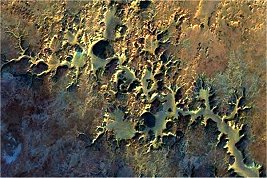

 |
Wadi Ard al Akhdar |
The lower reaches of Wadi Ard al Akhdar were entered by Shaw in 1935, but it was Bagnold and company who explored it's long winding upper reaches. In a side branch they have come upon a narrow passage that was blocked by a large transverse dune in neolithic times, and a substantial lake filled the broad basin behind. At some time the sand dam had been breached and washed away, only some cemented remnants can be seen along the south side of the narrows, opposite the much smaller modern dune growing in the same place. Subsequently the mud floor of the lake has been much eroded, leaving free standing mud pillars and terraces littering the basin floor.
Oliver Myers, the archaeologist of the Bagnold expedition made an initial survey, and found numerous neolithic settlement sites on the top of the mud terraces. He only took a few samples though, and no systematic exploration was made.
In the mid 1980-s the Heinrich Barth Institut have extensively studied the area, and the results of the several seasons' work has been published in detail by Werner Schön, making Wadi Ard al Akhdar the most studied, and best published prehistoric locality in the deep Libyan Desert. See:

|

|

|